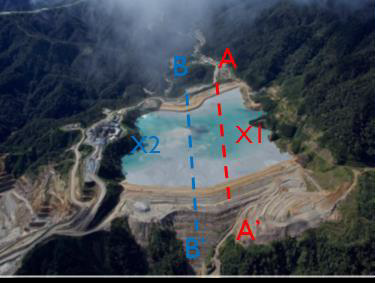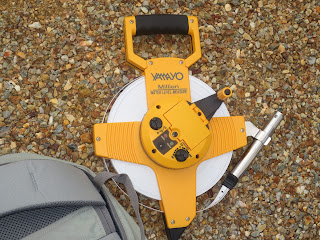1. Define environment (in
terms of mining).
Environment
is Conditions that affect working atmosphere and development of mining. Or is
the physical condition that exists in mines.
2. What is mining?
It is the
extraction of minerals from the earth.
3. Why does environment become
a subject to mining?
Because serious mine closure issues remain
after mine is closed so by taking environment as a subject to mining, the mine
closure issues can be addressed and must be known to the local people of what
is going on and what preventive measures that can be taken to protect people
and the natural environment.
4. What are main sources of
physical impacts by mining operations?
They are:
exploration, development and extraction.
5. What are main sources of
chemical pollution due to mining?
Main sources
of chemical pollution are cyanide and sulfuric acid for (leaching) and organic
reagents (flotation agents) from ore separation processes. Others include
mercury, toxic blast chemicals and hydrocarbon products run – off.
6. What particular problem
exists with both ferrous and precious metallic ores?
Acid mine
drainage is a particular problem in many mines and both ferrous and precious
metallic ores are the main sources of ARD.
7. What is the main concern of
trace metal concentrations?
The main
concern of trace metal concentration is that, when they are leached into the
river systems and streams it cause bioaccumulation which is a concern to the
river systems.
8. State the magnitude of
mineral’s contributions to economic growth in developed and developing nations.
High
proportions of minerals are mined in developing countries and so the economy of
poor countries depends largely on minerals whereas minerals contribute a small
portion to the economy of developed countries like USA, Japan and Great
Britain.
9. What are the effects of
increased demand for minerals?
The demand
for minerals increased as there was an increased in technology, development and
human civilization. As a result, environmental impacts of earth based resource
extraction increases.
10. Why is every mine different
and related environmental effects?
Because every
mine has different characteristics with respect to environment. These characteristics
include;
 Amount of materials removed.
Amount of materials removed.
 Deposit depth.
Deposit depth.
 Ore chemical composition
Ore chemical composition
 Ore process technology/techniques
Ore process technology/techniques
 Degree of stewardship practiced.
Degree of stewardship practiced.
11. Describe very briefly how
mineral is extracted by surface mining methods and underground methods.
In surface
mining method, the mineral is extracted by removing the overburden, drilled, blasted,
loaded and hauled to the processing plant.
In underground
mining methods, mineral deposits are extracted at certain depths. Ore is
drilled and blasted stopes, marked and hauled to the surface via hoisting
systems or diesel units.
12. What aspect of operation
distinguish surface from underground mining?
Underground
mine operations are complex compared to surface operations. Surface mining is
easy and cheap to operate because the ore deposit is near surface whereas underground
mining is hard and expensive to operate because mineral deposit is at certain
depth.
13. State the natures of environmental
impacts caused by mill operation, underground and surface mining respectively.
Riverine
Tailings from mill operation is dangerous as most mineral deposits are
associated with sulfur. In addition, smelting generate large amount of toxic
gas. Smelters cause regional pollutions where SO2 can travel considerable
distances and cause “acid rain” and climate change.
Potential
sources of water pollution include drainage from surface and underground mines,
waste water from beneficiation, and contaminated surface water from toxic blast
chemicals and hydrocarbon products run – off.
14. Why is chemical pollution
more serious than physical?
Because
chemical means are hard to reverse and these must be controlled at process
stage. But environmental impacts through physical impacts can be reclaimed
through rehabilitation during mining and post – mine period.
15. Differentiate tailings and
waste rock and describe respectively environmental impacts.
Tailings
compose mostly of mud and slurry containing high proportion of fine particles.
Mud and slurry tailings once exposed to air and rain cause oxidation, releasing
sulfuric acid, causing acid rock drainage. The suspended solids cause river bed
sedimentation, diversion of watercourses, flooding and destruction of aquatic
life.
Waste rock is
solid coarse materials from both surface and underground mines. Waste rock dump
occupy large portions of land, often outside the special mining lease under
lease for mining Purposes.
16. If Frieda Copper mine is
predicted to produce 1million/year ore at 0.45%Cu, what is the annual waste
material generated?
Data:
production = 1,000,000 tonness/year
grade = 0.45%
Annual waste
generated =????
Copper
concentrate = production x grade = 1,000,000 x 0.0045 = 4500 tonnes copper.
Annual wastes
= 1,000,000 – 4,500 = 995,500 tonnes of waste.
17. If Hidden Valley mine has
minable ore of 5minllion tones grading 2.5g/t Au, for mine life of 10 years,
the tailings dam should be designed to what capacity?
Data:
mineable ore = 5 million
Ore grade =
2.5g/t mine life = 10 years.
/year x 2.5g/t = 12,500,000 grams/year.
Total value
mineral = 10 years x 12,500,000 gram/year = 125,000,000 grams
In terms of tonnes = 125 tonnes.
Waste and
value minerals = 5,000,000 tonnes /year x 10 years = 50,000,000 tonnes of ore.
Therefore;
total waste generated would be = 50,000,000 tonnes – 125 tonnes = 49,999,875
tonnes.
So the
tailings dam should be designed in such a way that will cater for 49,999,875
tonnes of waste over the ten year period. If tonnage factor was given then the
answer would be expressed in volume.
18. What is beneficiation?
Describe it?
Is the entire
process of crushing, grinding, sizing and separation of ore into valuable
mineral and waste
In other
words it is the process that liberates mineral grains locked in rock/ore which
can be separated physically and chemically.
19. State the two types of
mineral separation and examples of each.
Two basic
means of separation are physical and chemical.
·
Physical separation involves; - (a) magnetic and (b) gravity separation.
·
Chemical separation methods are: (a) floatation (b) cyanidation (c)
amalgamation and (d) heap leaching.
20. Briefly describe the
processes: (a) heap leaching (b) cyanidation & (c) amalgamation.
 Heap leaching – is a process used to extract metal values from run – of
– mine ore. The ore is usually porous and readily soluble in aqueous solvent.
Heap leaching – is a process used to extract metal values from run – of
– mine ore. The ore is usually porous and readily soluble in aqueous solvent.
 Cyanidation – is a process for extracting gold or silver from ore by
treating the ore with a weak solution of sodium cyanide and recovering the
metal particles from the resulting solution.
Cyanidation – is a process for extracting gold or silver from ore by
treating the ore with a weak solution of sodium cyanide and recovering the
metal particles from the resulting solution.
 Amalgamation – is a method of extracting a precious metal from an ore by
using mercury to form an amalgam (an alloy of mercury and another metal) with
the metal.
Amalgamation – is a method of extracting a precious metal from an ore by
using mercury to form an amalgam (an alloy of mercury and another metal) with
the metal.































